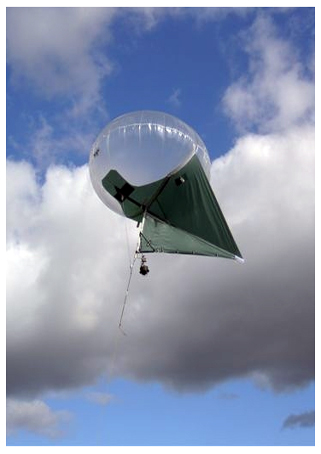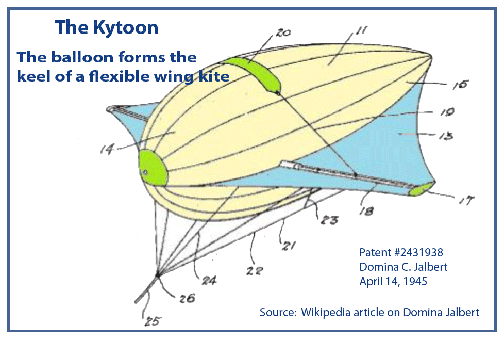Helikite - a Modern Improvement on the 'Kytoon'
The United States Army has invested time and money in a hybrid balloon-kite combination device that is designed to be a platform for low-level surveillance in areas where larger blimp-like aerostats or expensive drone aircraft are not feasible to use.
 Helikite with aerial camera by Allsopp Helikites Ltd.The Stars and Stripes news service released information and photos of "Helikites," a half-kite, half-blimp aircraft for low-level surveillance. It can readily be deployed by armed forces personnel for military purposes in remote areas where air-borne surveillance cameras would be useful.
Helikite with aerial camera by Allsopp Helikites Ltd.The Stars and Stripes news service released information and photos of "Helikites," a half-kite, half-blimp aircraft for low-level surveillance. It can readily be deployed by armed forces personnel for military purposes in remote areas where air-borne surveillance cameras would be useful.
This device, which combines the properties of a blimp and a kite, and carries communications and surveillance equipment, is among the pilotless flying equipment currently being tested by the Army base at Fort Benning, Ga., Stars and Stripes reported Monday, May 20, 2012.
According to Wikipedia, the names 'Helikite' and 'Helikites', are Registered Trade Marks relating to a type of kite-style aerostat designed and patented by Sandy Allsopp in England.1
UPI.com in its May 21, 2012 story entitled Army tests blimp-kite hybrid 'Helikites', stated:
Since many of the American military bases in Afghanistan are not large enough to accommodate and maintain the large aerostats that hover over battlefields and enemy lines, sending back photos and other information, "We are looking at small, more tactical aerostats that can be used at those small bases, " said Maj. Peter Moore, product director at the Fort Benning-based Rapid Equipping Force.
The Helikite is among the small aerostats being tested to learn how long launch and recovery operations take, how they perform in windy conditions and how long training programs for operating personnel will take, the newspaper said.
Helikites range in size from a model 6 feet long capable of lifting cameras and communications equipment, to an aircraft 24 feet long that can lift as much as 30,000 pounds of equipment, said Sandy Allsopp, owner of the British firm Allsopp Helikites, which makes the aircraft for the U.S. Air Force and Navy, and the British Army.
The Allsopp Helikites have a wide variety of peace time applications as well. The devices can be used for lifting:
- Scientific instruments and equipment
- Radio antennas and radio relay or jamming equipment
- Sensors and weather instruments
- Pollution sampling equipment
- Aerial photography and video cameras
- Acoustic sensing instruments
- Thermal imaging and mine detection devices
- Remote sensing and radar arrays
- Advertising displays.
In short, anything that needs stable aerial positioning can be lofted using the Helikites.
The modern version of the aerostat-kite hybrid has a historical precedent in the work of Canadian born Domina Jalbert, inventor of both the parafoil and the 'kytoon'.
Domina Jalbert, born in Saint-Jean-de-Matha, Quebec, moved with his family to the United States where he received a pilot's license and had a deep interest in kites. Early on, Jalbert had a small advertising business using large kites.
Jalbert worked for the United States Rubber Company which built barrage balloons to help protect the coast line of the United States from attacks by enemy aircraft. Barrage balloons were large tethered aerostats that dangled metal cables that were designed to inflict damage on low-level aircraft that came into collision with the cables.
Since tethered balloons are affected by strong winds which tend to drive them lower in altitude and make them oscillate at the end of their tethers, Jalbert took his knowledge of kites and began to develop a hybrid balloon-kite device which he called a "kytoon".
Using the balloon to form the keel of a kite, Jalbert affixed kite-like wings to the keel. The effect of the wings was to both create lift when a wind was blowing and to stabilize the kytoon so that it would not wildly oscillate across the sky at the end of its tether.
 Jalbert's Patent Drawing of the Kytoon from Wikipedia.
Jalbert's Patent Drawing of the Kytoon from Wikipedia.
Jalbert's patent was filed on April 14, 1945, near the end of World War II. After the war, the kytoon did not receive much attention and it gradually drifted into obscurity. Jalbert went on to design and patent the parafoil in 1964. His contributions to kites and steerable parachutes have made him one of the great kite pioneers.
Allsopp's Helikite is a much improved hybrid aerostat-kite device over that envisioned by Jalbert back in 1945. The Helikite still embodies the concept of lift via the balloon when the air is still. It also uses the properties of the kite when the winds come up: lifting the device against the wind to ensure that the payload is sustained in its elevation and does not dart wildly from side to side on its tether.
In a May 21, 2012 posting on the Wired web site, Katie Drummond wrote an article about the Helikite entitled "Battle-Kites’ Eyed for Afghan Spy Duty". In the article she stated:
The Helikites, which are already used by the British Army, are also rather wee: The vehicles currently range in size from 6 to 24 feet in length. For comparison’s sake, consider that the Air Force’s much-contested Blue Devil 2 blimp, which might one day soar the skies above America instead of Afghanistan, measures a whopping 370 feet.
Blimps rely on helium to get them off the ground and keep them airborne. By adding a kite to the mix, the Helikite boasts an enhanced flying ability — one that’d increase its ability to haul cargo, which is likely to include plenty of surveillance gear. A 24-foot Helikite, according to its parent company, Allsopp Helikites, can lug 30,000 pounds of equipment. That’s five times the weight that aerostats of a similar size can lift. All that, and the Helikites can fly as high as 6,000 feet — keeping them safely out of range from gunfire or grenade attacks.
The military is also testing the battle-kite’s ability to help with communications in far-flung regions. A hovering battle-kite, equipped with communications gear, could offer mobile networks that’d vastly improve the sketchy wireless linkages currently available in remote realms of combat. According to the company, a Helikite elevated to 600 feet should be able to yield 113 square miles of Wi-Fi coverage.
And the Helikites, which cost an estimated $50,000 apiece, also have a key advantage over the other aerostats in the military’s array: Because they’re so small, and benefit from the wind-catching powers of a kite, they require way, way less helium.
That’s good news for the Pentagon, which is already facing potential helium shortages from keeping so many aerostats aloft. In a report issued just last year, the Defense Logistics Agency lamented that “industry cannot keep up with the increased [helium] demand” required by all those blimps.
Clearly, Allsopp's Helikite is an up-to-date device that should prove to be very useful in both military and peace time applications. Although their is similarity in concept to the historical kytoon developed by Domina Jalbert in the mid-1940's, the Helikite is clearly a superior device that is multi-functional and highly utilitarian.
It is interesting to reflect on the history of the kytoon as we appreciate the advances made with the design of the Helikite.
__________________________
Notes:
- 1From the Wikipedia article entitled Helikite.
- There is also a video of the Helikite available on the Wired.com site. It is hosted on YouTube.com
- An interesting article about the work and contributions of Canadian born kite pioneer Domina Jalbert can be found in the Popular Mechanics article He Flies Kites for Love and Money by author George Sand. Popular Mechanics, Vol. 109, No.3, March 1958 - Pages 82-86 and 248. The article features several photographs of Jalbert's kites and devices as well as a line drawing of the kytoon.
References (3)
-

-

-
 Source: He Flies Kites for Love or Money
Source: He Flies Kites for Love or Money





Reader Comments